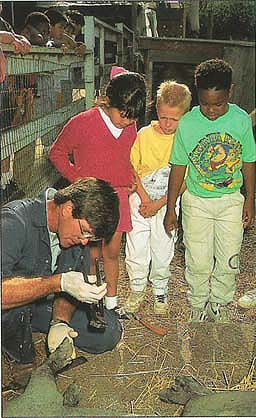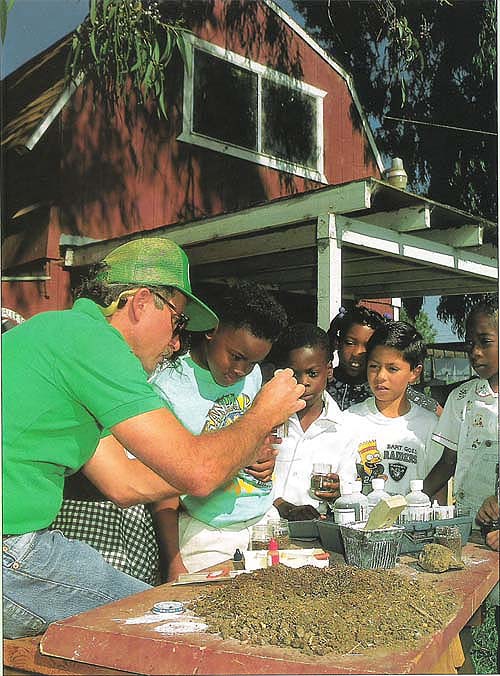All Issues
Sidebar: Snapshots of current agricultural literacy programs
Publication Information
California Agriculture 45(6):6-7.
Published November 01, 1991
PDF | Citation | Permissions
Abstract
Abstract Not Available – First paragraph follows: Site visits to selected schools provided snapshots of agricultural literacy programs across the state. Schools were chosen to represent a wide variety of situations.
Full text
Loma Vista Farm - once a weed-infested patch of hard clay dirt – is today a five-acre site with livestock, poultry, rabbits, waterfowl, a one-acre vegetable garden, a hydroponic greenhouse, barns and a classroom. Seventeen years ago Loma Vista teachers and students, –with the assistance of the Solano County 4-H leader – began to till the dirt, haul in the manure, and obtain the seed. Today, recycling and conservation are an integral part of the farm. Monitors from Loma Vista school take all the leftovers from lunch down to the farm and sort out the aluminum, tin, glass and food materials, the latter to be used as farm compost.At left, children learn characteristics of Aracana chickens in an educational scavenger hunt.*
Site visits to selected schools provided snapshots of agricultural literacy programs across the state. Schools were chosen to represent a wide variety of situations. In order of importance, selection criteria were:
-
community size and urbanicity (i.e., urban to rural);
-
geographical region;
-
curricular approach, educational strategy, and program focus.
Most sites selected were identified from the survey sent to county superintendents and UC Cooperative Extension (CE) county directors.
We found that the staff at each site showed exemplary commitment to developing their students' agricultural understanding, often through “learning-by-doing.” The use of agricultural themes as a basis for instructional design appeared to fit well with the new California educational frameworks, which emphasize thematic approaches to teaching.
Although we found staff members to be generally upbeat about what they were accomplishing, personnel at each site told us they considered their program's future to be at risk due to lack of adequate funding and district administrative support. In most cases, staff at these sites had given little thought to formal evaluation of program effectiveness, as illustrated by one director who, when asked how he knew his program was successful, stated, “Because our phone rings off the hook.”
Analysis of these programs reveals that good agricultural literacy programs require at least four components: (1) a dedicated, visionary leader; (2) a high level of commitment from the staff and administrators; (3) a strong link between agricultural literacy education and classroom-based learning; and (4) adequate material resources.
The sample included the following programs:
Anderson Valley Ag Institute at Anderson Valley High School in the rural community of Boonville, a fertile agricultural valley in Mendocino County. Formerly a traditional vocational agriculture program with a small enrollment, the institute now offers a wide range of agricultural courses to 90 students.
Loma Vista Farm, adjacent to Loma Vista Elementary school in Vallejo, located in Solano County. The area was a weed-filled, five-acreparcel when Loma Vista teachers and students began cultivating part of it in September of 1974. Today the farm is a school-community project that offers a multitude of teaching and learning opportunities for students and adults.
Manual Arts High School in south central Los Angeles. Manual Arts is a comprehensive three-year high school with 1,800 students and a 50% daily attendance rate. One special education instructor teaches science, using a former vocational agriculture area of the school as her outdoor science lab.
Markham Junior High School in Watts, a low-income area of Los Angeles. Seventh and eighth grade students (approximately 90 students per year) work on horticultural and floricultural projects on a 1/4-acre garden site on the school campus.
Mewah Mountain High School, a continuation high school in Larkspur in Marin County. Approximately 20 students, 16 to 18 years old, attend afternoon classes in an agroecology program. The goal of the program is to enable students to continue their education. Students strive to attain academic success and the confidence and ability to grow food in an environmentally sustainable manner.
Rock Creek School, a K-6 elementary school located in Auburn, a rapidly growing semi-rural community east of Sacramento. The school houses a Life Lab garden site with program emphasis on science and nutrition. The lab coordinator and individual classroom teachers rotate class use of the site. Life Lab is a life science curriculum developed in the early 1980's in a Santa Cruz school district and adopted nationwide.
Victory Elementary School in Stockton in San Joaquin County. The agricultural literacy programs here are conducted by kindergarten and fifth-grade teachers who attended the “Ag in the Classroom” summer training seminar for teachers. Neither grade teaches a separate unit on agriculture, but both integrate agricultural concepts into their science, history, social studies, literature and math units.
More than 10,000 Vallejo school district students visit Loma Vista Farm each year, from kindergarten through high school, including special needs students. Many days there are 150 students using the facility — taking interpretive walks, harvesting sunflowers, weighing baby animals, compiling information in science journals, gathering eggs, and baking bread in adobe ovens. Above, a veterinarian checks and trims hoofs of Yucatan swine:
Above, Loma Vista Farm instructor demonstrates the differences between the composted soil of the farm, and the hard-packed clay dirt in the surrounding area.
At right, students gather a chick to be weighed, part of the “chick it out” math project. Due to an early reliance on extramural funding for the farm (and required reports), Loma Vista personnel collected data that indicated significant gains (p<0.01) in both reading and math for students attending sessions at the farm when compared with non-farm involved students. Throughout the initial grant period (and continuing to date), learning-disabled students were integrated into activities on the farm. As with the founding study, data for the three years indicates improved performance for all three target groups, the regular elementary, the trainable mentally retarded, and the learning disabled students.









